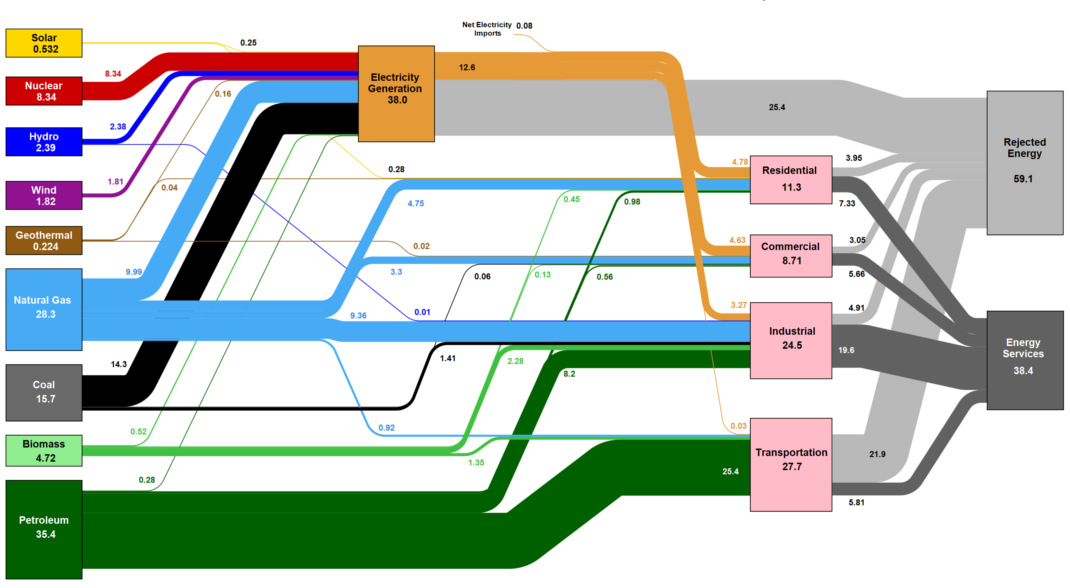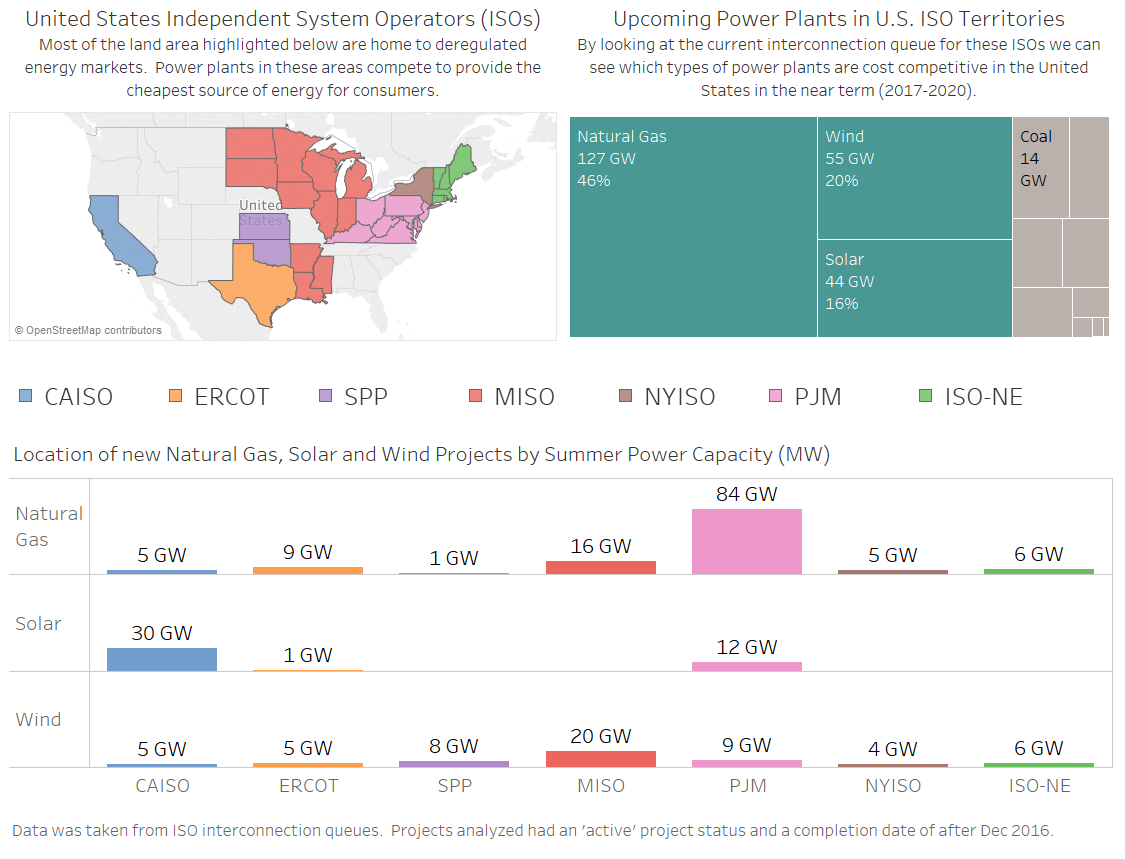Despite the hype around renewables, it takes time, money, and new technology to build out these plants at a scale that will make a difference.
As a result, many people are still surprised that solar and wind constitute less than 2% of energy generated in the U.S. as of 2015:
Click here for a larger version of this giant diagram.
Yes, oil is the big dog for now, and it will continue to be that way for the foreseeable near-term.
However, the switch to renewables is gaining momentum fast.
We noted earlier this year that solar and wind capacity grew 31% and 5% respectively between 2014 and 2015. However, the following news is even more significant, since it shows that new power coming online from renewables is happening at a scale that will make a considerable dent in the actual energy mix.
New Power Coming Online
The following infographic comes to us from Mantena Notes, and it looks at new energy capacity coming online in the territories of different United States Independent System Operators (ISOs). First, some background: ISOs are grids in the U.S. that are deregulated, where power plants compete to provide electricity at the lowest price. This infographic looks at what is in their interconnection queues, which are essentially waiting lines for new power plants that have applied to become a part of the grid.
It should be noted that the above additions do not technically represent the whole U.S., but it does help give an idea of what the market is moving towards and what is cost effective. The aforementioned ISOs constitute a very significant chunk of the overall market. This is how the new power coming online breaks down:
46% natural gas (127 GW) 20% wind (55 GW) 16% solar (44 GW) 5% coal (14 GW) 9% other (35 GW)
The low gas price environment makes switching to natural gas easy, and thus gas makes up the most gigawatts of new capacity coming online. Solar and wind combine for 99 GW of upcoming capacity, which is significant by almost any measure. For comparison, the largest ever peak in California’s electricity demand occurred on July 24, 2006 for 50.3 GW. That definitely moves the needle.
on
#1: High Reliability
Nuclear power plants run 24/7 and are the most reliable source of sustainable energy. Nuclear electricity generation remains steady around the clock throughout the day, week, and year. Meanwhile, daily solar generation peaks in the afternoon when electricity demand is usually lower, and wind generation depends on wind speeds.As the use of variable solar and wind power increases globally, nuclear offers a stable and reliable backbone for a clean electricity grid.
#2: Clean Electricity
Nuclear reactors use fission to generate electricity without any greenhouse gas (GHG) emissions.Consequently, nuclear power is the cleanest energy source on a lifecycle basis, measured in CO2-equivalent emissions per gigawatt-hour (GWh) of electricity produced by a power plant over its lifetime. The lifecycle emissions from a typical nuclear power plant are 273 times lower than coal and 163 times lower than natural gas. Furthermore, nuclear is relatively less resource-intensive, allowing for lower supply chain emissions than wind and solar plants.
#3: Stable Affordability
Although nuclear plants can be expensive to build, they are cost-competitive in the long run. Most nuclear plants have an initial lifetime of around 40 years, after which they can continue operating with approved lifetime extensions. Nuclear plants with lifetime extensions are the cheapest sources of electricity in the United States, and 88 of the country’s 92 reactors have received approvals for 20-year extensions. Additionally, according to the World Nuclear Association, nuclear plants are relatively less susceptible to fuel price volatility than natural gas plants, allowing for stable costs of electricity generation.
#4: Energy Efficiency
Nuclear’s high energy return on investment (EROI) exemplifies its exceptional efficiency. EROI measures how many units of energy are returned for every unit invested in building and running a power plant, over its lifetime. According to a 2018 study by Weissbach et al., nuclear’s EROI is 75 units, making it the most efficient energy source by some distance, with hydropower ranking second at 35 units.
#5: Sustainable Innovation
New, advanced reactor designs are bypassing many of the difficulties faced by traditional nuclear plants, making nuclear power more accessible.
Small Modular Reactors (SMRs) are much smaller than conventional reactors and are modular—meaning that their components can be transported and assembled in different locations. Microreactors are smaller than SMRs and are designed to provide electricity in remote and small market areas. They can also serve as backup power sources during emergencies.
These reactor designs offer several advantages, including lower initial capital costs, portability, and increased scalability.
A Nuclear-Powered Future
Nuclear power is making a remarkable comeback as countries work to achieve climate goals and ultimately, a state of energy utopia. Besides the 423 reactors in operation worldwide, another 56 reactors are under construction, and at least 69 more are planned for construction. Some nations, like Japan, have also reversed their attitudes toward nuclear power, embracing it as a clean and reliable energy source for the future. CanAlaska is a leading exploration company in the Athabasca Basin, the Earth’s richest uranium depository. Click here to learn more now. In part 3 of the Road to Energy Utopia series, we explore the unique properties of uranium, the fuel that powers nuclear reactors.































